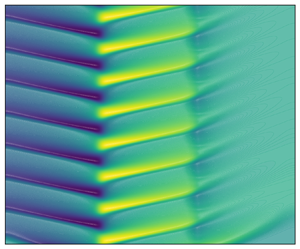Crossref Citations
This article has been cited by the following publications. This list is generated based on data provided by
Crossref.
Castellanos, R.
Cornejo Maceda, G. Y.
de la Fuente, I.
Noack, B. R.
Ianiro, A.
and
Discetti, S.
2022.
Machine-learning flow control with few sensor feedback and measurement noise.
Physics of Fluids,
Vol. 34,
Issue. 4,
Varela, Pau
Suárez, Pol
Alcántara-Ávila, Francisco
Miró, Arnau
Rabault, Jean
Font, Bernat
García-Cuevas, Luis Miguel
Lehmkuhl, Oriol
and
Vinuesa, Ricardo
2022.
Deep Reinforcement Learning for Flow Control Exploits Different Physics for Increasing Reynolds Number Regimes.
Actuators,
Vol. 11,
Issue. 12,
p.
359.
Viquerat, J.
Meliga, P.
Larcher, A.
and
Hachem, E.
2022.
A review on deep reinforcement learning for fluid mechanics: An update.
Physics of Fluids,
Vol. 34,
Issue. 11,
Shinde, Saurabh
and
Bali, Harneet Singh
2022.
Instructions with Complex Control-Flow Entailing Machine Learning.
p.
33.
Masclans, Núria
Vázquez-Novoa, Fernando
Bernades, Marc
Badia, Rosa M.
and
Jofre, Lluís
2023.
Thermodynamics-informed neural network for recovering supercritical fluid thermophysical information from turbulent velocity data.
International Journal of Thermofluids,
Vol. 20,
Issue. ,
p.
100448.
Vignon, C.
Rabault, J.
and
Vinuesa, R.
2023.
Recent advances in applying deep reinforcement learning for flow control: Perspectives and future directions.
Physics of Fluids,
Vol. 35,
Issue. 3,
Vignon, Colin
Rabault, Jean
Vasanth, Joel
Alcántara-Ávila, Francisco
Mortensen, Mikael
and
Vinuesa, Ricardo
2023.
Effective control of two-dimensional Rayleigh–Bénard convection: Invariant multi-agent reinforcement learning is all you need.
Physics of Fluids,
Vol. 35,
Issue. 6,
Sirignano, Justin
and
MacArt, Jonathan F.
2023.
Deep learning closure models for large-eddy simulation of flows around bluff bodies.
Journal of Fluid Mechanics,
Vol. 966,
Issue. ,
2023.
How to control hydrodynamic force on fluidic pinball via deep reinforcement learning.
Physics of Fluids,
Vol. 35,
Issue. 4,
Yu, Tao
Wu, Xiaoxiong
Yu, Yang
Li, Ruizhe
and
Zhang, Hao
2023.
Establishment and validation of a relationship model between nozzle experiments and CFD results based on convolutional neural network.
Aerospace Science and Technology,
Vol. 142,
Issue. ,
p.
108694.
Gkimisis, Leonidas
Dias, Bruno
Scoggins, James B.
Magin, Thierry
Mendez, Miguel A.
and
Turchi, Alessandro
2023.
Data-Driven Modeling of Hypersonic Reentry Flow with Heat and Mass Transfer.
AIAA Journal,
Vol. 61,
Issue. 8,
p.
3269.
Xu, Da
and
Zhang, Mengqi
2023.
Reinforcement-learning-based control of convectively unstable flows.
Journal of Fluid Mechanics,
Vol. 954,
Issue. ,
Li, Yiqing
Noack, Bernd R.
Wang, Tianyu
Cornejo Maceda, Guy Y.
Pickering, Ethan
Shaqarin, Tamir
and
Tyliszczak, Artur
2024.
Jet mixing enhancement with Bayesian optimization, deep learning and persistent data topology.
Journal of Fluid Mechanics,
Vol. 991,
Issue. ,
Ren, Kai
Gao, Chuanqiang
Xiong, Neng
and
Zhang, Weiwei
2024.
Adaptive control of transonic buffet and buffeting flow with deep reinforcement learning.
Physics of Fluids,
Vol. 36,
Issue. 1,
Chen, Jie
Zong, Haohua
Song, Huimin
Wu, Yun
Liang, Hua
and
Su, Zhi
2024.
Closed-loop plasma flow control of a turbulent cylinder wake flow using machine learning at Reynolds number of 28 000.
Physics of Fluids,
Vol. 36,
Issue. 1,
Ren, Feng
Wen, Xin
and
Tang, Hui
2024.
Model-Free Closed-Loop Control of Flow Past a Bluff Body: Methods, Applications, and Emerging Trends.
Actuators,
Vol. 13,
Issue. 12,
p.
488.
Xia, Chengwei
Zhang, Junjie
Kerrigan, Eric C.
and
Rigas, Georgios
2024.
Active flow control for bluff body drag reduction using reinforcement learning with partial measurements.
Journal of Fluid Mechanics,
Vol. 981,
Issue. ,
Ishize, Takeru
Omichi, Hiroshi
and
Fukagata, Koji
2024.
Flow control by a hybrid use of machine learning and control theory.
International Journal of Numerical Methods for Heat & Fluid Flow,
Vol. 34,
Issue. 8,
p.
3253.
Brahmachary, Shuvayan
and
Thuerey, Nils
2024.
Unsteady cylinder wakes from arbitrary bodies with differentiable physics-assisted neural network.
Physical Review E,
Vol. 109,
Issue. 5,
Mohammadikalakoo, Babak
Kotsonis, Marios
and
Doan, (Nguyen) Anh Khoa
2024.
Optimization of Tollmien-Schlichting waves control: comparison between a deep reinforcement learning and particle swarm optimization approach.




